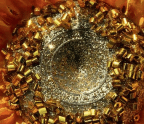

inko Kawauchi’s book , published in 2020, chronicles her daughter’s first three years of life. As the baby grows, her actions and movements start to resemble things in the world. She grasps a person’s shoulder in a manner that calls to mind a drop of water sticking to a leaf. Her foot acquires the pokiness of a tree branch. Her fists, held in another’s older grip, are reminiscent of an insect’s clinging. The baby stands, reaches to touch thresholds within and outside the home; she looks at doors, white curtains, the edge of bubbles, the shoreline of a beach. Then she begins grasping for objects: a bowl, an insect, a camera, her grandfather’s coffin. The last page of the book features the girl in blue sneakers, holding a length of wheat. She observes it carefully, as though it reminds her of something else: a firework, perhaps, or a memory. Kawauchi writes in the book that her own body during these years was like “a conduit, made for connection.” But a conduit to where? “The baby was like having an alien






